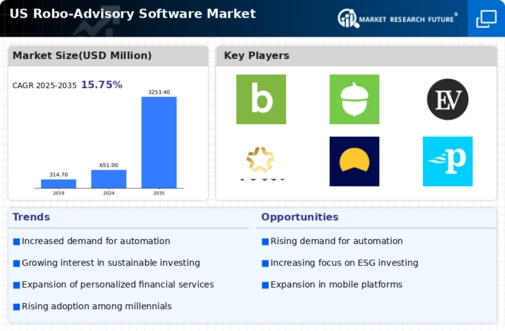Shift Towards Sustainable Investing
The shift towards sustainable investing is becoming a prominent driver in the robo advisory-software market. As investors increasingly prioritize environmental, social, and governance (ESG) factors in their investment decisions, robo advisors are adapting their offerings to meet this demand. Many platforms now provide options for socially responsible investing, allowing users to align their portfolios with their values. This trend is particularly appealing to younger generations, who are more likely to invest in companies that demonstrate a commitment to sustainability. The growing interest in ESG investing may lead to an expansion of the robo advisory-software market, as firms that incorporate these principles into their services could attract a larger client base.
Increased Financial Literacy Among Consumers
The rise in financial literacy among consumers is significantly impacting the robo advisory-software market. As individuals become more educated about investment options and financial planning, they are more inclined to utilize automated solutions that simplify the investment process. Educational initiatives and resources have contributed to a more informed investor base, which is likely to seek out robo advisory services for their ease of use and accessibility. This trend suggests a growing acceptance of technology-driven financial solutions, potentially leading to an increase in market penetration. The robo advisory-software market may benefit from this shift as more consumers recognize the advantages of automated investment management.
Technological Advancements in Financial Services
Technological advancements are playing a pivotal role in shaping the robo advisory-software market. Innovations in artificial intelligence (AI), machine learning, and big data analytics are enhancing the capabilities of robo advisors, allowing them to provide more personalized and efficient services. For instance, AI algorithms can analyze vast amounts of data to optimize investment strategies, while machine learning can adapt to changing market conditions. As these technologies continue to evolve, they are likely to attract a broader audience, including tech-savvy investors who value efficiency and innovation. The integration of advanced technologies may also lead to improved user experiences, further driving growth in the robo advisory-software market.
Regulatory Support for Digital Financial Services
Regulatory support for digital financial services is emerging as a key driver for the robo advisory-software market. In the US, regulatory bodies are increasingly recognizing the importance of fintech innovations and are implementing frameworks that facilitate the growth of digital advisory services. This supportive regulatory environment encourages the development and adoption of robo advisory platforms, as firms can operate with greater confidence in compliance. Furthermore, regulations that promote transparency and consumer protection are likely to enhance trust in robo advisory services, thereby attracting more users. The evolving regulatory landscape may serve as a catalyst for growth in the robo advisory-software market.
Growing Demand for Cost-Effective Investment Solutions
The robo advisory-software market is experiencing a notable surge in demand for cost-effective investment solutions. As traditional financial advisory services often entail high fees, consumers are increasingly seeking alternatives that offer lower costs without compromising on quality. Robo advisors typically charge fees ranging from 0.25% to 0.50% of assets under management, significantly less than the 1% to 2% charged by traditional advisors. This shift towards more affordable options is particularly appealing to younger investors and those with smaller portfolios, thereby expanding the market's reach. The trend indicates a potential growth trajectory for the robo advisory-software market. More individuals are recognizing the value of automated investment management in achieving their financial goals.























Leave a Comment